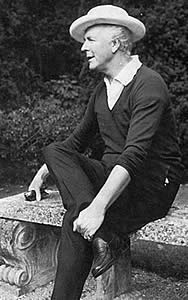

Issue 15 . Summer 2004
On a Carousel... . The Poovy Past . That Furious Lesbian . New in the Archive . Plus Ca Change
The Poovy Past
How long has Brighton been a weekend magnet for gay London professionals with a taste for antiques, interior decor and the company of camp old ladies? Since the Sixties, you might well say. But a rare account of gay life in Brighton during the Thirties reveals that in this town, at least, some things never change.
Extracted from the 1976 autobiography of Peter Coats, who was in advertising
during the Thirties and later a distinguished garden writer and designer.
"In the middle thirties I acquired a flat in Brighton. Staying away every
week-end in large and sometimes draughty country houses was all very well in
summer but not so enjoyable in winter. Hunting and shooting were of no interest
to me, and most of the people I knew seemed to be obsessed with those two pursuits.
So I found a flat in Brighton - at 36 Brunswick Terrace - for which I paid the
princely rent of £90 a year. It was up three flights of stairs, had three
main rooms and overlooked the sea. At first I shared it with Collie Knox, at
that time a successful journalist and editor of a column called "Collie
Knox Calling" in the Daily Mail. Collie and I sometimes went down
to the flat together - and sometimes used it on alternate weeks - a system which
worked well, as we had different friends.
 |
 |
Peter Coats |
Collie Knox |
I have always been fond of Brighton and I really enjoyed those cold, sunny weekends by the sea, going for long walks as far as Rottingdean to the east and Shoreham, with its dilapidated little harbour, to the west.
The Brighton flat saw my first efforts at decoration, and I still have some pieces of furniture I bought for it. A mahogany drum table (£3 10s at Maples second-hand furniture department) and a papier-maché chair (thirty shillings). The walls were painted white - the carpet was coconut matting, and the curtains were of red and white striped mattress ticking. I thought it very smart.
After a year or so, Collie lost interest in Brighton and wanted a cottage in the country, and Gerald Wellesley, then a practising architect, asked if he could share the flat with me. Gerry's brother, the Duke of Wellington, was married to a Coats cousin, Maudie. Later Maudie's son was killed in the war, in Italy, and Gerry became Duke. He was a connoisseur, a historian and a man of great culture, obsessed with his iron ancestor. Though correctly distressed at his nephew's death, he made no pretence at not being delighted at becoming a Duke. He once told me that it was "like having a birthday everyday".
With Gerry I met some of the more colourful inhabitants of Brighton. First and foremost there was Pepita's daughter, Lady Sackville, who lived out towards Rottingdean and whom her own daughter, Victoria Sackville-West, described as "entirely dominating, triumphing, warm hearted, frequently mistaken, generous, regardless... one forgave her everything when one heard her laugh."
Lady Sackville was a lavish present-giver. But her presents were apt to be either too expensive to accept without embarrassment, or verging on rubbish. Once she offered me a choice, a knife and fork of silver gilt which had once been in the Wallace collection, or a knitted hot-water-bottle cover in the form of a poodle. I weakly took the poodle. Lady Sackville spoke an inimitable English - or rather French interspersed with English words. Gerry hated taking unnecessary taxis, though at that time one could get anywhere in the Brighton area for two shillings; and one evening, when we arrived ten minutes late for dinner, she greeted us with the words, " Je pensais que vous avez missed the bus."
Another neighbour in Brighton whom I met through Gerry was the playwright Edward Knoblock, author of the highly successful play Milestones and inventor, it has been said, of the fashion for Regency furniture. He had a little house above the Metropole Hotel filled with the most delectable objects. I was much younger than either Eddie or Gerry, and I used to walk home from dining with them with my head spinning with all the wise and witty conversation I had heard. They both taught me much.
Brighton in those days was a wonderful place for buying cheap antiques and junk. The shops in the Lanes were not so grand and expensive as they are now. On Saturdays there were several enticing street markets. Both Gerry Wellesley and Eddie were avid and discerning antique collectors, though both had very specialized tastes. One day we were all three out together, combing the shops in the Lanes. We got separated, and on my own, I bought a little cream-coloured ceramic pot - faintly oriental, with a lid and small handles in the shape of lions' heads, on either side. I was sure it was an important find, and probably very early Chinese, T'ang or Sung at least. I exhibited my treasure (price five shillings) with pride, but was greeted with laughter. It was a pâté de foie gras jar."
Of Generals and Gardens, Weidenfeld & Nicholson, 1976.
Back to top of page
Back to Ourstory home page